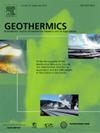Hydrochemical characteristics of carbonated waters and non-carbonated thermal waters of the Heyuan Deep Fault Zone in Guangdong, Southern China
IF 3.9
2区 工程技术
Q3 ENERGY & FUELS
引用次数: 0
Abstract
This paper studied both carbonated geothermal waters and generic geothermal waters, to better understand deep groundwater circulations in deep fault-basin system in the Heyuan Deep Fault Zone. Uniquely occurring carbonated geothermal waters are not well known in their origin-evolution process, geologic settings of deep ground water systems, and their flow behaviors in response to the unique physicochemical properties. Through deep-borehole data, and field samplings of various isotope and aqueous geochemistry data, we characterized these carbonated and generic geothermal waters, and analyzed water-rock reactions in relevant silicate rocks. Carbonated waters have high contents of HCO3− and dissolved CO2, and enhance their leaching effect in such a way consequently leading to much higher major ion concentrations than non-carbonated thermal waters. According to δD and δ18O data, both carbonated waters and non-carbonated waters are of local meteoric origin and recharge from the hilly areas scattering throughout the study area at elevations ranging from 492 to 602 m (masl). The δ13C results confirm that the high DIC contents in carbonated waters have their deep sources of both mantle and carbonate rock thermal metamorphism genesis. Thermal reservoir temperatures are estimated for water samples, yielding a temperature range of 48.2 to 134.8 °C, based on chalcedony and quartz geothermometers. A 3500-m-deep borehole for carbonated water has revealed the relatively low geothermal gradient (2.35 °C/100 m) in the carbonated water convergence zone, which is related to the localized depression of the granitic-igneous basement within the study area. Relatively low-temperature environments have formed in localized basement depressions with thick cover of sedimentary rocks, and thus have provided excellent storage condition for deep-derived CO2 rising along deep faults, forming carbonated waters when combined with groundwater systems. The deep crustal groundwater flow was further examined for the crustal thermo-structure, showing the heat flow and temperature distribution in each layer of the crust. The findings and insights could provide further understanding of deep ground water flow systems and deep groundwater circulations. The implications involve effective exploitations and utilizations for carbonated water and non-carbonated thermal water. This study is the first of the kind to study the deep ground water systems including carbonated waters and non-carbonated thermal waters in deep fault-basin systems, in terms of the deep sourcing, ground-water circulation, and thermal structure of the deep crust, and deep groundwater circulation in deep fault settings.
广东河源深断裂带碳酸水与非碳酸热水的水化学特征
为了更好地了解河源深断裂带深部断盆系统的深部地下水循环,本文对碳酸地热水和一般地热水进行了研究。独特赋存的碳酸地热水的成因演化过程、深层地下水系统的地质背景以及其独特的物理化学性质对其流动行为的响应尚不清楚。通过深孔资料、各种同位素和水地球化学资料的野外采样,对这些碳酸盐岩和普通地热水进行了表征,并分析了相关硅酸盐岩石中的水岩反应。碳酸水具有较高的HCO3−和溶解CO2含量,并以这种方式增强了它们的浸出效果,从而导致主要离子浓度远高于非碳酸热水。δD和δ18O数据表明,碳酸水和非碳酸水均为局地大气成因,补给来自分布在海拔492 ~ 602 m (masl)的丘陵地区。δ13C结果证实了碳酸化水体高DIC含量的深层成因既有地幔热变质成因,也有碳酸盐岩热变质成因。根据玉髓和石英地温计,估计了水样的热储层温度,温度范围为48.2至134.8°C。3500 m深碳酸水钻孔显示,碳酸水辐合带地温梯度相对较低(2.35℃/100 m),这与研究区内花岗-火成岩基底局部凹陷有关。在沉积岩覆盖较厚的局部基底坳陷中形成了相对低温的环境,为深源CO2沿深断裂上升提供了良好的储存条件,与地下水系统结合形成碳酸水。进一步考察了地壳深部地下水流动对地壳热结构的影响,显示了地壳各层的热流和温度分布。这些发现和见解可以进一步了解深层地下水流动系统和深层地下水循环。这涉及到碳酸水和非碳酸热水的有效开发利用。本研究首次从深部源、地下水循环、深部地壳热结构、深部断裂环境地下水循环等方面研究了深断盆地系统中碳酸水和非碳酸热水的深层地下水系统。
本文章由计算机程序翻译,如有差异,请以英文原文为准。
求助全文
约1分钟内获得全文
求助全文
来源期刊

Geothermics
工程技术-地球科学综合
CiteScore
7.70
自引率
15.40%
发文量
237
审稿时长
4.5 months
期刊介绍:
Geothermics is an international journal devoted to the research and development of geothermal energy. The International Board of Editors of Geothermics, which comprises specialists in the various aspects of geothermal resources, exploration and development, guarantees the balanced, comprehensive view of scientific and technological developments in this promising energy field.
It promulgates the state of the art and science of geothermal energy, its exploration and exploitation through a regular exchange of information from all parts of the world. The journal publishes articles dealing with the theory, exploration techniques and all aspects of the utilization of geothermal resources. Geothermics serves as the scientific house, or exchange medium, through which the growing community of geothermal specialists can provide and receive information.
 求助内容:
求助内容: 应助结果提醒方式:
应助结果提醒方式:


